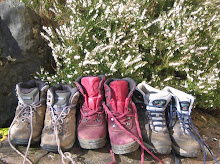
Rust Never Sleeps
The gloriously translucent light of that one day of Indian Summer that the Isle of Mull enjoyed in late September, as reflected in the colours and shadows cast on this Bramble leaf – 28/09/11

When Death Becomes You
The decaying fruiting body of this Russula toadstool provides the sustenance necessary for the emergence and development of the parasitic fungus Asterophora parasitica. Like many fungi, this organism has, so far, been spared the moniker of a universally accepted common name. We call it the Violet Necro-fungus, for its capacity to sustain life when all around it has called it a day! – 28/09/11
 A Hidden Agenda
A Hidden AgendaIt is hard to imagine that an army of tiny Gall Wasps will emerge from the cluster of Silk Button Spangle Galls littered on the underside of these oak leaves. Yet, having endured the Winter among the leaf litter and assorted detritus on the woodland floor that’s exactly what will happen next Spring. Around 90 different species of minute Gall Wasps inhabit Britain’s parks and woodlands, yet very few human beings ever get the opportunity to see them. Indeed, if life was but a game of hide and seek, then these little insects may never be found! – 13/09/11
 Candy-Striped Cling-Ons
Candy-Striped Cling-OnsAs light travels through the sea water that immerses these Purple Topshells, the attractive lime green and deep purple colours of this grazing mollusc’s protective coat shimmer and dazzle, like a child’s spinning top. To overturn a rock at the tide-line on the Isle of Mull will often reveal a myriad of previously hidden marine life, of which a variety of periwinkles and topshells may be most obvious, not to mention colourful – 27/09/11

Mare Serenitatis
Regardless of your religious leaning (or none), it is impossible not to visit the white shell sand beaches and aquamarine waters of the sacred Isle of Iona without being affected by a pervading sense of peace and calm. Yet, Iona has had to endure many natural and man-made storms during its history; storms that created the flower-rich machair of the West coast and sacked the early monastery during a time of Viking rule. Today, even a day visit to this wonderful little island offers a very tangible unburdening of everyday stresses accumulated by many visitor’s mainland lives – 06/07/11

































